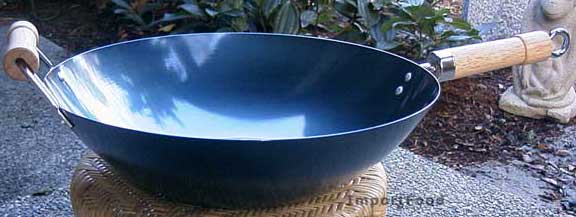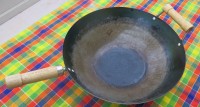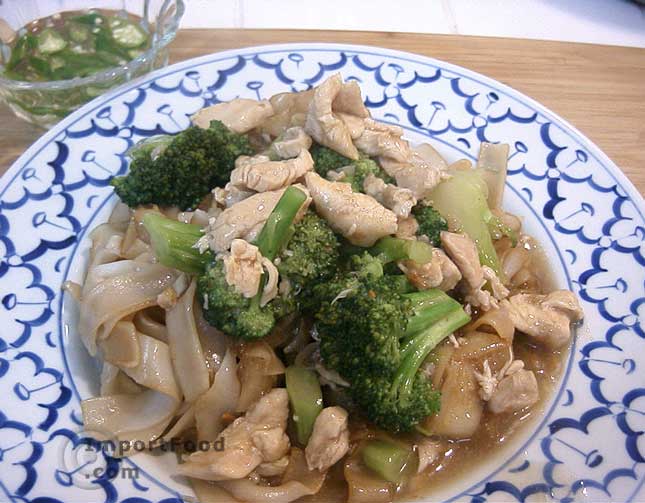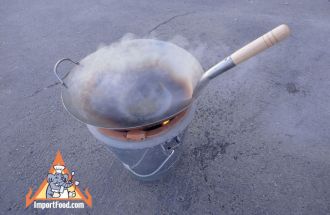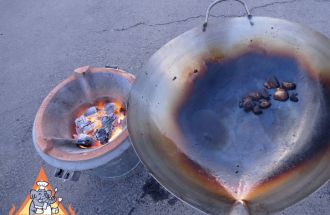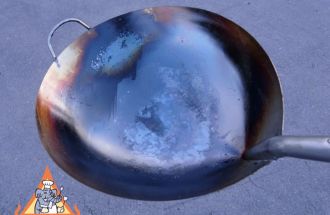14" Carbon Steel Wok, Side-Handle Flat Bottom
Add to cartTemporarily Out of Stock Please see our Street Vendor Wok.
Our most popular wok, this is a flat-bottom wok which sits directly on the burner and allows for ease of use on American stove tops (and many cooks like the stationary flat-bottom). Very functional, it comes with two wood handles--a main handle and a wide side grip.
This wok is fairly heavy, with relatively thick steel. Carbon steel is superior for fast efficient heating and even heat distribution. It can withstand the high temperatures necessary for stir-fry cooking yet does not peel or crack. Most importantly, it's natural. The wok is easy to use and care for--just a small amount of oil added to the hot wok primes the easy-release surface. We also include an instruction booklet for cleaning and care.
It's preseasoned which means a coating of vegetable oil was applied at high temp. You still need to season the wok further, for best results (see below "how to season a wok"). See recipe below for Lad Na as we made it using this wok.
We've used this same wok for over 10 years. Ours is nicely seasoned, see picture below.
The wok is 14" in diameter, and the flat base is 7" in diameter. Made in Taiwan. We suggest using this with our bamboo steamer set. We offer a dome lid for the wok but it's not necesary.
Thai-Style Wide Noodles In Thick Sauce, 'Kuaytiao Lad Na'
Lad Na is prepared in a two-step recipe that involves first frying wide rice noodles until they're just starting to get crispy. Then a sauce is quickly made and poured over the noodles. The translation of Ladna in English is "Pour on the Face".
Lad Na is served all over Thailand, so it can be considered a national Thai dish, see a sidewalk version here that's over 40 years old. It's typically served not spicy, with Thai condiments on the side to "fix the taste" and make it more spicy if that's desired. In Thailand, broccoli or "pak kanaa" is typically used. It's very good with asparagus as well.
How to Season Your Wok
Seasoning a steel wok is simple, and very important because it gives your wok an all-natural non-stick coating. Food glides over the surface of a properly seasoned wok without sticking at all. This is a smoky process, so you'll need to have good ventilation or do it outside.
Cleaning. Start by thoroughly cleaning your wok. Our street vendor woks come with a sticker right in the middle of the cooking surface, inconvenient but not difficult to remove. Peel away what you can, then use fingernail polish (acetone). If you don't have any around the house, you can buy a bottle for about $1. Acetone is an organic solvent, excellent for cleaning your wok the first time. Pour 1-2 tablespoons directly into the wok and swirl it around, then scrub with a paper towel or rag. Thoroughly clean both sides of your wok this way, removing all dirt, oil and residue. Next wash it with soap and water, and wipe dry. Now you have a bare, perfectly clean steel wok ready to season.
Seasoning. Put a few tablespoons of peanut oil in your wok, and as it heats up, swirl the oil around to coat the entire inside of the wok. Let the wok get really hot (so the oil smokes), then use a folded paper towel to wipe the oil around the sides of the wok. Hold the paper towel with chopsticks or tongs. Keep doing this for a few minutes or more, pulling the wok away from the heat occasionally to wipe the oil around. Dump any remaining oil out.
Put a tablespoon or two of oil back into your wok, and add several cloves of garlic. Using garlic and/or shallots is a great way to season your wok. Put it back on the heat, this time tipping your wok so the heat goes directly onto the side of the wok. Keep spreading the oil around, and rotate the wok so the entire inside surface becomes blackened. Throw out the blackened garlic.
With 1/2 cup of oil in a dish, dip folded paper towel into the oil and start seasoning again, over medium/high heat, wiping the insides of the hot wok with oil. You can repeat this half a dozen times. After 30 minutes or so, the entire inside of the wok is nice and brown/black. This coating is essentially carbon, and is no risk to your health. Congratulations! You've created a homemade nonstick surface, naturally.
Our Thai Street Vendor Wok sticker says the following in Thai language: 1. For the first use. Roast your wok by turn it over on top of the fire for 10 minutes keep moving until all turn to dark gray evenly. 2. Clean and wipe dry then roast your wok same way above for 20 minutes until the wok color change to dark brown. 3. Clean and wipe dry.
Care. Never scrub your wok with a scouring pad, as it will remove the seasoning. Just use water and a mild sponge after use, and wipe dry. Restaurant chefs simply pour water into a wok after each dish is prepared, bring the water to a quick boil, wipe the wok with a bamboo brush, dump the water and start the next dish. If your wok is used infrequently, wipe the dry wok with vegetable oil and this will prevent rust in storage.
Wok Seasoning Tips from Ronald in Holland. Ok, I'll try my best English here. Obviously I didn't buy a wok set from these guys because I live in Holland. Then again I recognized the brand they sell immediately. It's slightly thicker than China wok sets. Go ahead and buy them if your serious about cooking. By all means you won't regret it. Don't ever think you have a wok burner in your home similar to what street vendors have. That's where the thicker carbon steel is a plus. Fortunately I have a stove with a reasonable large burner but I never lower the heat, instead I take the wok away from the heat for short moments. (Never touch the controls!)
About seasoning: Use detergent only once with hot water to remove oil residue etc. Flush/rinse and set your gas-burner to the max and leave it this way. Now really burn-in your wok. Making sure the flames hit every corner (if any) on your wok. Typical colouring should appear (OCC exhaust type) when you think you're done, continue until the steel turns nearly dark, and turn of the heat. Now moisten? (slightly wet) a paper towel with good quality sesame oil or if you're allergic to that, sunflower oil. Rub the inside of your wok with this towel, it should smoke a lot. That's it you're done. Cleaning: Bamboo brush and hot water, goodbye Mr. Muscle and other crxp!. Enjoy!
Do I need to tell you more. Yes I'm afraid so. Get yourself 3 woks! 1 for sweet and sour dishes. 1 for spicy either meat or fish dishes. Finally 1 for egg/omelet dishes and only for that!. You can use your meat/fish; wok for noodles and or rice recipes just as long as you remember to make it piping hot!
Wok Seasoning
Wok Seasoning
Wok Seasoning

